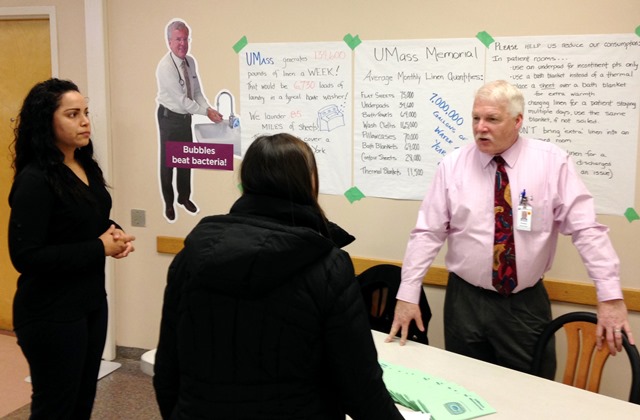Linen Awareness to Promote Water and Energy Savings
Imagine taking clean clothes from your closet at home and washing them, even though you haven't worn them. Sound wasteful?
That's the idea UMass Memorial Medical Center asked people to think about at its first "Linen Awareness" event held December 10, 2014 at the University Campus.
 |
||||
|
Melissa Vargas (left) and Jeffrey Haselton (right) discuss the linen |
"We want to raise awareness about the volume of linen we use, and talk about ways to reduce our linen laundering without compromising the safety or comfort of our patients," said Jeffrey Haselton, linen manager at UMass Memorial Medical Center.
Haselton and Melissa Vargas, customer relationship manager at Angelica Corp., the medical center's laundry vendor, staffed an information table at the University Campus cafeteria to engage with staff and discuss linen usage. On the wall nearby they displayed large posters with some of the metrics of linen and laundering at the medical center.
Here are some of the numbers: on a typical month, the three campuses of the medical center utilize 75,000 flat bed sheets, 69,000 pillow cases, 165,000 wash cloths, 64,000 bath towels, 34,600 underpads, and other linen items. Add it all up by weight, and the medical center generates 7 million pounds of laundry each year. On just University Campus, the daily volume is the equivalent of 471 loads of laundry in a typical home washing machine.
The challenge, Haselton said, is that much of the linen washed is not used by patients. The medical center's protocol states that as soon as a piece of linen is placed in a patient room, it is considered dirty and must be laundered, whether or not it was ever used. This is an important standard for patient safety, Haselton said, but it's a process that can be wasteful. Too often hospital staff will place extra sheets and towels in a room, even if the patient is being discharged that same day. So checking on the discharge time before replenishing a room is an easy step that could yield significant savings, he said.
In addition, Haselton said staff members often double-up on linens for patients when a single sheet, blanket or underpad is fully appropriate. "We have to educate our people to be more aware of what's really needed in that patient's room," Haselton said.
Angelica Corp.'s specialized laundry process insures all linens are properly cleaned and disinfected, Vargas said. The company's equipment is highly efficient, using only 1 gallon of water per pound of laundry, compared to 2.7 gallons per pound for most home washing machines. Yet with 7 million pounds of linen requiring 7 million gallons of water, even a modest reduction in linen use can save a significant amount of water and energy.
"By taking some simple steps, we believe we can reduce our linen use by 20 percent, without compromising patient safety or comfort," Haselton said. "We will always change soiled linen, and provide patients with what they ask for, but we can also improve our processes to be more efficient and reduce usage."
